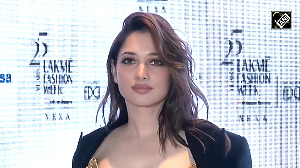A week before a good friend's wedding in Jodhpur, I am starting to panic. What is the difference between a casual shalwar kameez and a dressy shalwar kameez? Should I go sari-shopping in Southall or Mumbai? I flick through old issues of Hello! magazine, looking at Liz Hurley dressed up as an Indian princess for her wedding, courtesy of her famous designer friends: Versace, Valentino and Cavalli. My panic mounts.
But after touching down in Mumbai, I pick up a copy of Vogue India, which happens to have the coverline "Signature styles for the wedding season". I call the magazine to find out more.
"Going to an Indian wedding is about embracing traditionalism," says fashion editor Deep Kailey.
So, I ask, are there any fashion rules that I should know about?
"People go all-out and don't shy away from opulence. The rule is to wear colour and avoid black and white, which is for mourning."
We head straight for Fabindia, a sort of Topshop version of the Conran Shop. Launched in 1960, Fabindia doesn't advertise and is the champion of Indian ethnic chic. Every item it sells must have one handcrafted element. I'm even told that because of its combination of social responsibility and commercial success, Fabindia is a Harvard Business School case-study, but that isn't so unusual in India these days.
The colours of the country haven't changed in the decade since my last visit, but what is new is the conspicuous wealth. Electrical goods stores are open late at night, and roads designed for rickshaws are choked with shiny four-wheel drives.
In Fabindia I am struck by the shop's modern, timber-clad interior. Girls sipping smoothies argue over the choice of bed linen with husbands sporting baseball caps. A woman appears from the changing rooms lugging an oversized, feathered handbag that I've seen in British Vogue.
For the sangeet (a night of musical entertainment), I buy a long silk kameez in scorching pink, which is worn with a long scarf called a dupatta. My less ornate kameez for the mehendi, a lunch during which the ladies' hands are decoratively hennaed, is pale paisley silk minus the sequins. If you're used to skinny jeans then churidars, the tightly fitting trousers worn beneath the kameez, feel stylish and urban.
When we arrive in Jodhpur, home of the riding trousers, I'm taken to Raju's Sarees, where yards of chiffon spill across the floor. This is where it all begins: Jade Jagger's trinkets, Matthew Williamson's sequined dresses. I buy a sari in Rajasthan red - blood red - edged with heavy silver sequins, then wonder what to do with it. Luckily, the night before the wedding our hotel holds a sari workshop.
Within minutes I've lost my loop, and without a loop I can't make pleats to tuck into the front of the sari to fashion a skirt. Before I know it I'm back in my petticoat and blouse with 12 feet of fabric gathered about my ankles. Did Liz Hurley feel this inadequate the night before her Indian wedding?
The next morning, desperate for help, I accost a woman who appears from her hotel room resplendent in emerald green. Taking pity on me, she unravels the sari I have stuffed unevenly into my petticoat and starts again. I'd imagined drowning in layers of fabric, but I was wrong. Tight at the waist, with enough room to walk but not so much that the figure is lost, the sari feels as elegant as it looks. When I'm complimented on how well I've folded it, I don't argue.
Back in London, depressed by the cold and the tyranny of black, I adorn my wrists with bangles and drape a pink shawl around my shoulders. "I want to wear a sari to our wedding," I tell my boyfriend, who is half-Brazilian. He looks amused.






 © 2025
© 2025